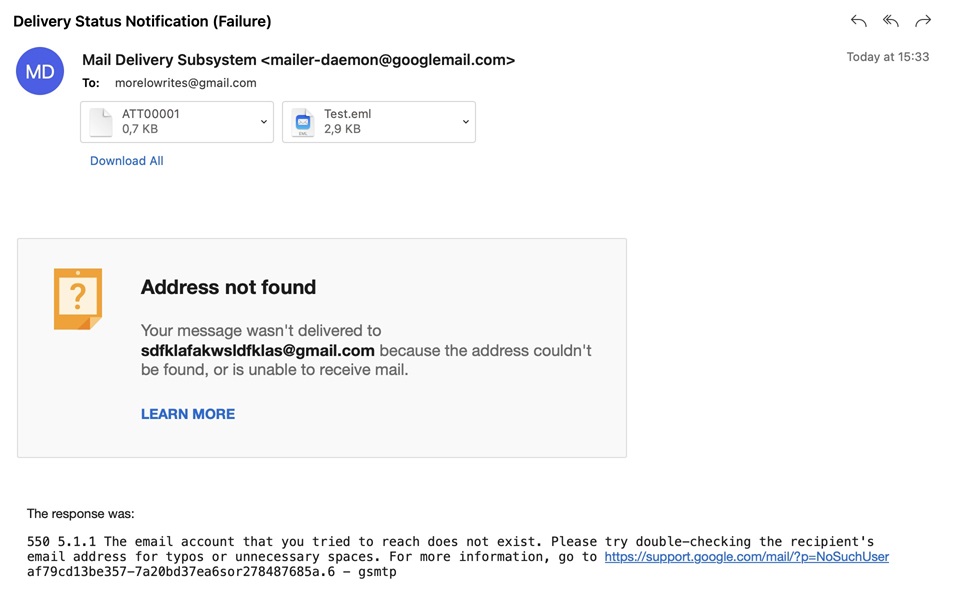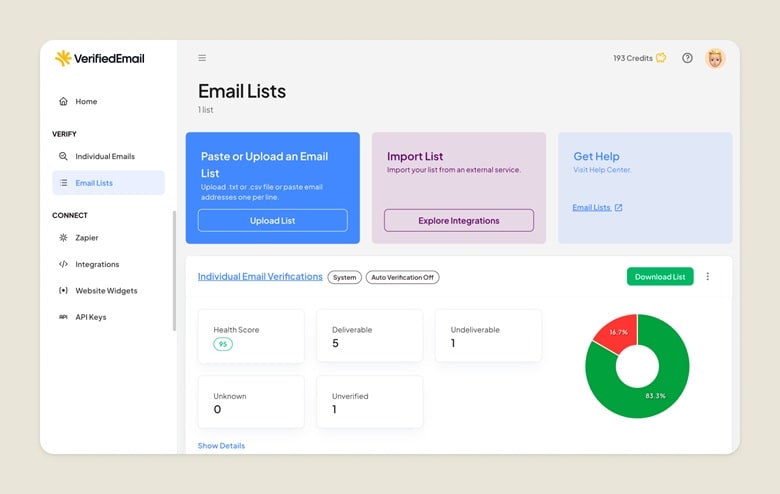Hard Bounce vs Soft Bounce In Email: Understand The Difference
As an email marketing specialist, you want every single message to land perfectly in your subscribers' inboxes. However, some messages will bounce back and never reach the recipient. Getting a handle on the difference between a hard and soft bounce is the first step to keeping your email deliverability rates high and your sender reputation intact.
First Things First—What is an Email Bounce?
📌 A bounced email can feel like a punch to the gut, but it's just a digital notice from a recipient's email server telling you your email message couldn't be delivered. Depending on the reason, an email will bounce back with a specific code, flagging it as either a permanent failure (hard bounce) or a temporary one (soft bounce).
Bounce messages—both hard and soft—typically include details explaining why the email couldn't be delivered.
For instance, emails bouncing may indicate that the recipient's address doesn't exist, as shown in the example image, where the message clearly states, "Address not found."

The message often includes a response code and additional information about the issue, which can help diagnose the problem and take appropriate action, such as list cleaning using VerifiedEmail to improve email deliverability and sender score. The included information is the biggest difference between hard and soft bounce email messages.
What is a Soft Bounce vs Hard Bounce?
So, what separates these two? It’s all about whether the delivery problem is a dead end or just a temporary roadblock.
Hard bounce
This bounce happens when a message is permanently undeliverable. The email address might be fake, have a typo, or simply no longer exist. In other cases, the recipient's email server has decided it wants nothing to do with you and has blocked your address completely. It’s a permanent "return to sender."
Soft bounce
A soft bounce is a temporary delivery failure. It happens when the email address is valid, but the email server couldn't deliver the message right now. There are many different reasons, including a full inbox, a server that’s temporarily down or overloaded, or an email message that’s too large. In these scenarios, there’s still a chance the email could be delivered later.
Understanding SMTP Codes: Difference Between Hard Bounce and Soft Bounce
When an email bounces back, it comes with a little message that hints at what went wrong. These messages are called SMTP response codes, and they’re like a big clue saying, “Here’s the issue.”
- Codes that start with 4xx (like 421 or 451): These are soft bounces. Think of it as the server saying, “Not right now, buddy.” It’s a temporary problem, so you can usually try sending the email again later.
- Codes that start with 5xx (like 550 or 553): These are hard bounces. This is the server’s way of saying, “Nope, not happening.” It’s a permanent issue, and you should remove that email address from your list ASAP.
Hard Bounce vs Soft Bounce: Key Differences
| Aspect | Hard Bounce | Soft Bounce |
|---|---|---|
| Nature of the problem | Permanent | Temporary |
| Typical causes | Invalid email address, non-existent domain, recipient email server permanently blocking the email due to policy or spam filters | Full inbox, server issues, message too large, domain name temporarily unavailable, email blocked due to content, email fails to meet recipient server's policies |
| Immediate action required | Yes | Not always |
| Impact on sender reputation | Severe | Severe (but only if persistent) |
| Effect on email deliverability | Significant negative impact | Significant negative impact (but only if persistent) |
| Recommended response | ❌ Remove from the list immediately | ⚠️ Monitor and retry sending (remove if necessary) |
Both hard and soft bounces can have a severe and long-lasting impact on your mail campaigns, significantly damaging your sender reputation (which is pretty much your trust score with ISPs like Gmail and Outlook) and leading to decreased email deliverability rates.
But a hard bounce is the real killer—they never resolve on their own. It’s a direct signal that you’re not maintaining a clean list. Think of it as sending a snail mail to an address where the house was torn down years ago. The post office is going to get sick of you pretty quickly.
⚠️ As such, they require immediate action—the removal of the offending address from your mailing list.
And while soft bounces are less damaging in isolation, they can't really be ignored either. If an address consistently soft bounces over several campaigns, ESPs (Email Service Providers) will start treating it like a hard bounce.
You need a solid strategy to avoid both. There’s a need to closely monitor every address that has caused a soft bounce and remove it if necessary.
How to Reduce Hard and Soft Bounces
This is a snippet from a Reddit thread, but if you’re a marketer, this sounds so familiar, just like you wrote it yourself!
Keeping your bounce rate low—regardless of what type—is non-negotiable. A high bounce rate kills your deliverability, wastes your budget, and can get you blacklisted.
The good news is that learning how to reduce your bounce rate isn't difficult. You have more control than you think!
The other good news? We’ve got you. Here are some tips to kill those bounced messages with relative ease. (While these tips won't entirely eliminate hard bounce and soft bounce in marketing, they can greatly reduce their occurrence and mitigate their impact on your campaigns.)
Start with a clean list
This is ground zero. You wouldn’t build a house on a shaky foundation. So you also wouldn’t build a marketing campaign on a dirty list.
📌 Use an email verification service
Before you even think about hitting "send" on a new list, run it through a verification tool.
Use email verification services like VerifiedEmail to validate your mailing list on a regular basis. Such services perform a host of checks to detect both soft and hard bounces without negatively impacting your sender reputation.

VerifiedEmail checks each email address to see if it’s valid and can accept mail, all without sending a single email (manual checks sound so tedious!).
Seriously, it’s the single best way to slash your hard bounces from the get-go.
📌 Implement double opt-in
Make subscribers confirm their email address when they sign up (and before you send the first message). Yes, you might lose a few people who can't be bothered to click the confirmation link. In the whole scheme of things, that's a small price to pay for a squeaky-clean list.
The ones who do are engaged, and you know for sure their email address is legit. In the realm of email marketing, quality over quantity. Always.
Maintain List Hygiene Religiously
Your list isn't a "set it and forget it" thing. It needs regular maintenance.
📌 Create a suppression list
This is your "do not send" list. Any email address that results in a hard bounce should go here immediately and automatically. This also applies to people who unsubscribe or mark your messages as spam.
📌 Segment your audience
Don’t just blast the same message to everyone. Guerilla marketing is so 1990s anyway! Segmentation is now the name of the game. So segment your list based on engagement.
For instance, if a group of subscribers hasn't opened a message in six months, send them a re-engagement campaign. If they still don't bite, it might be time to let them go.
Inactive, old email addresses are often the main culprit of bounces. Proactive list management isn't just a best practice; it's a campaign-saver.
📌 Warm-up your IP
If you’re sending from a new IP address or domain, you can’t just start blasting thousands of emails. You need to "warm it up" by sending small batches of emails to your most engaged users first and gradually increasing the volume. This builds trust with ISPs.
Watch out for nuances
Not all email addresses are created equal. There are some (rather discreet) pitfalls to watch out for.
📌 The "catch-all" domain problem
Some domains are set up as "catch-alls," meaning they accept messages sent to any address at that domain, even non-existent ones. This sounds great, but it can hide problem addresses that should be hard bounces. A good verification service can often identify these for you.
📌 Other bounce types
While hard and soft are the main players, you might see terms like "pending" or "global" bounces. A pending bounce is one your ESP is still trying to deliver. A global bounce is an address that’s on a universal suppression list across your ESP’s entire system because it's known to be problematic.
📌 Solid sender reputation
We’ve already mentioned that this is how Google and Yahoo can trust you. Maintain a good sender reputation by following the best practices in email marketing, such as those described in this article. The higher your sender reputation, the lower the chance of your messages ending up in recipients' spam folders.
📌 Proving you’re legit
Authenticate your messages using SPF, DKIM, and DMARC protocols to prove that you're a legitimate sender and not a spammer.
Optimize, optimize, optimize
Bounced messages aren’t just because of marketing lists.
Optimize message content and design to make your messages easily deliverable across all major mail services. In particular, you should keep your HTML code clean and simple, use a balanced text-to-image ratio, avoid using spam trigger words in your subject lines and content, and be careful with attachments.
Wrap-Up: Hard and Soft Bounces Are a Reality of Email Marketing
Hard bounces and soft bounces in email marketing are part of the game—a game that all marketers have to play if they want to succeed in their campaigns.
But they don’t have to derail your efforts. The solution isn't to stop reaching out to your audience. It's to send them smarter. Challenge the idea that a bigger list is always better. Focus on a clean, engaged list.
Be ruthless about removing bad addresses and lazy about adding unverified ones. By using email verification tools like VerifiedEmail, practicing good list hygiene, and paying attention to what your bounce reports are telling you, you can keep your sender reputation strong and ensure your messages get where they need to go.
Verify 200 emails for free. For lists over one-million emails, we will beat the price of any competitor, guaranteed.

